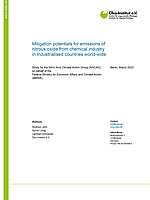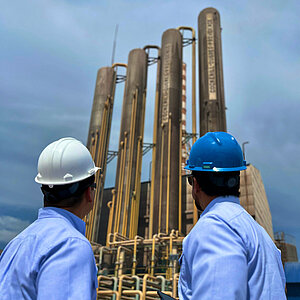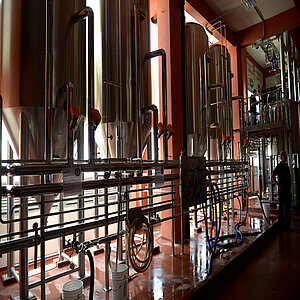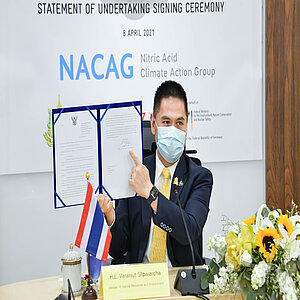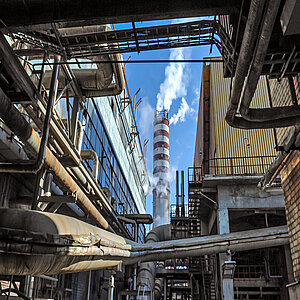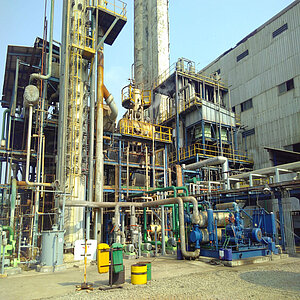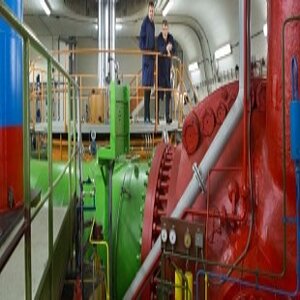“Creating a level playing field on a global scale”
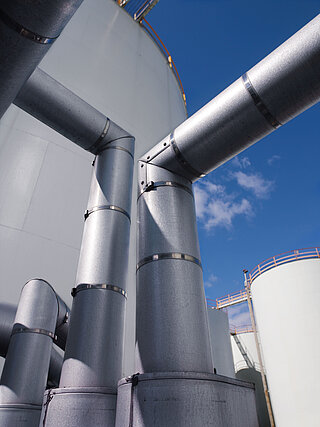
BMU State Secretary Jochen Flasbarth on NACAG as a global sectoral initiative and its relation to the NDC process in the implementing countries.
N2O is an extremely harmful gas. By comparison, it is more than 250 times more climate-damaging than CO2. N2O is primarily produced in the production of nitric acid. In order to reduce the emissions there worldwide, the Nitric Acid Climate Action Group (NACAG) is committed to the use of technical solutions. Jochen Flasbarth, State Secretary at the Federal Ministry for the Environment, Nature Conservation and Nuclear Safety (BMU), in an interview on the objectives of NACAG, results achieved so far and the transferability of the approach to other sectors.
Mr Flasbarth, could you please explain the rationale behind the launch of the Nitric Acid Climate Action Group and its link to the Paris Agreement?
The Paris Agreement marks a major paradigm shift in international climate policy. For the first time, all member states committed to set their own emissions targets and regularly review them to be more ambitious. With the Nitric Acid Climate Action Group (NACAG), BMU launched an initiative which follows the spirit of the Paris Agreement, providing climate finance and technical support to developing countries for realising the cost-effective mitigation potential of the nitric acid sector. The Action Group therefore contributes to raising ambitions by encouraging the partner countries to include the nitric acid sector in their Nationally Determined Contributions (NDCs) to the Paris Agreement. A key element of NACAG is that the partner countries need to commit to ensuring that the emissions from the sector will be mitigated permanently. NACAG only provides financial support to countries which have made this firm commitment.
Why does the initiative target the nitric acid sector globally?
The intention was to pick a sector where the abatement of emissions is particularly cost-effective, and for which widely proven mitigation technologies are available. The global mitigation potential in this sector is substantial as nitrous oxide has a global warming potential of 265 relative to CO2 and, in some countries, emissions from nitric acid production account for a considerable share of total national emissions. Therefore, in working towards the Paris Agreement goals, this sector cannot be ignored. NACAG promotes the early achievement of this potential within national mitigation strategies, the raising of ambitions and the updating of NDCs.
Under the Clean Development Mechanism, plant operators from developing countries were given an incentive to mitigate emissions and monetise the resulting emission reductions. However, when the price for these credits dropped, we observed that the mitigation activities in some countries stopped and that many plant operators uninstalled the technology to save on maintenance costs, leading to a rise in emissions. Through NACAG, we aim to revive these abatement activities on a global scale. We would also create an incentive for the plant operators which have not been active under the CDM to begin to address these emissions and to encourage governments to regulate emissions nationally and include them in the NDCs. Hence, the NACAG can serve as an example of how mitigation measures, which previously took place under the CDM, can be transferred into countries’ NDCs and therefore be part of a long-term sustainable solution.
What are the innovative aspects and what made this approach unique when it was launched at the COP in Paris?
To achieve the goals of the Paris Agreement any new initiative needs to have a strong focus on concrete implementation leading to measurable results. However, capacity building and the transfer of technology and knowledge are also important factors. The NACAG initiative combines all of these to reach its vision and goals.
Providing grant-based finance for companies to purchase mitigation and monitoring technology conditioned on a long-term political commitment was innovative. The initiative also offers a market and results-based financing option with the Nitric Acid Climate Auction Program. NACAG’s aim is for all nitric acid plants worldwide to operate with effective N2O abatement technology thus contributing towards transforming this industrial sector globally and creating a level playing field on a global scale.
From a pure business perspective, plant operators do not have an incentive to abate the N2O emissions from nitric acid production. How can it be ensured that the emission reductions achieved through NACAG will be permanent?
NACAG links direct financial support with the partner countries’ long-term political commitment to greenhouse gas mitigation in this sector. The key criterion for gaining access to NACAG’s financial support is that countries where the supported nitric acid plants are located must confirm that they will implement suitable measures to ensure that the emission reduction activities continue after the initiative’s support has ended. This can for example be achieved through market-based approaches, such as an emissions trading scheme operating in the European Union but also through direct regulation via emission limits. We see different approaches being evaluated and implemented in a variety of countries. We support partner governments in the design of instruments to measure N2O emissions and regulate their abatement as well as on ways of including the nitric acid sector in the countries’ NDCs.
How do the governments and the industry react to NACAG’s offer?
Since NACAG was launched in 2015, there have been discussions with around 30 countries, namely those which produce nitric acid and are eligible to receive official development assistance. So far, thirteen countries have joined the action group by signing a Declaration of Support.
 Throughout the work on NACAG, we have received positive signals from both the industry and governments in many countries. The governments understand and embrace the opportunity to use NACAG’s offer to raise their ambitions under the current NDC revision process and nitric acid producers often welcome the offer of technical and financial support. Several plant operators have proactively contacted NACAG to engage in emission reduction activities. We are also regularly invited to speak about NACAG at major industry events. These are signs that industrial companies are increasingly aware of their responsibility and the importance of addressing climate change.
Throughout the work on NACAG, we have received positive signals from both the industry and governments in many countries. The governments understand and embrace the opportunity to use NACAG’s offer to raise their ambitions under the current NDC revision process and nitric acid producers often welcome the offer of technical and financial support. Several plant operators have proactively contacted NACAG to engage in emission reduction activities. We are also regularly invited to speak about NACAG at major industry events. These are signs that industrial companies are increasingly aware of their responsibility and the importance of addressing climate change.
Could you tell us a bit more about how NACAG operates and what has been achieved so far?
In my opinion, a key success factor is the continuous dialogue between all relevant stakeholders, especially partner governments and plant operators. In addition to making financial resources available, NACAG advises its partners on a technical level. It is our goal to support the partner countries throughout the entire process of sustainably transforming the nitric acid sector.
We have conducted more than 30 workshops, performed numerous technical feasibility studies at plant level and advised partner countries on adequate policy instruments through country-specific studies. In some countries, for example Tunisia and Zimbabwe, we are in the final stages of a grant agreement for the implementation of N2O abatement activity, and other countries such as Mexico and Georgia have made good progress towards the same goal.
NACAG started as a pilot initiative in the nitric acid sector. Would you say that the NACAG approach could be replicated in other sectors? If so, which sectors could these be?
I would like to highlight that the nitric acid sector was selected as several characteristics make it particularly favourable for a global action group approach such as NACAG. The main aspects being that proven mitigation technology is readily available and easy to install resulting in a high yield of emission reductions per individual measure at comparatively low mitigation costs per tonne of CO2 equivalent. Another important aspect is the limited number of stakeholders involved, which makes it possible to provide individual technical advice and financial support.
The NACAG approach combines financial and technological support with a long-term commitment from the participating countries. While it may be difficult to find a set-up as distinct as the nitric acid sector in any other industry, the NACAG approach, or a very similar approach, can generally be applied to sectors that also meet or come close to meeting these characteristics. One example could possibly be seen in caprolactam production facilities which, like nitric acid plants, generate N2O as a by-product and where the same abatement technologies could be applied. A similar approach could also be used in large municipal landfills that have poor or non-existent waste management systems and produce high levels of methane.
This interview was first publish in the Carbon Mechanisms Review.
The link has been copied to the clipboard
Contact
IKI Office
Zukunft – Umwelt – Gesellschaft (ZUG) gGmbH
Stresemannstraße 69-71
10963 Berlin




